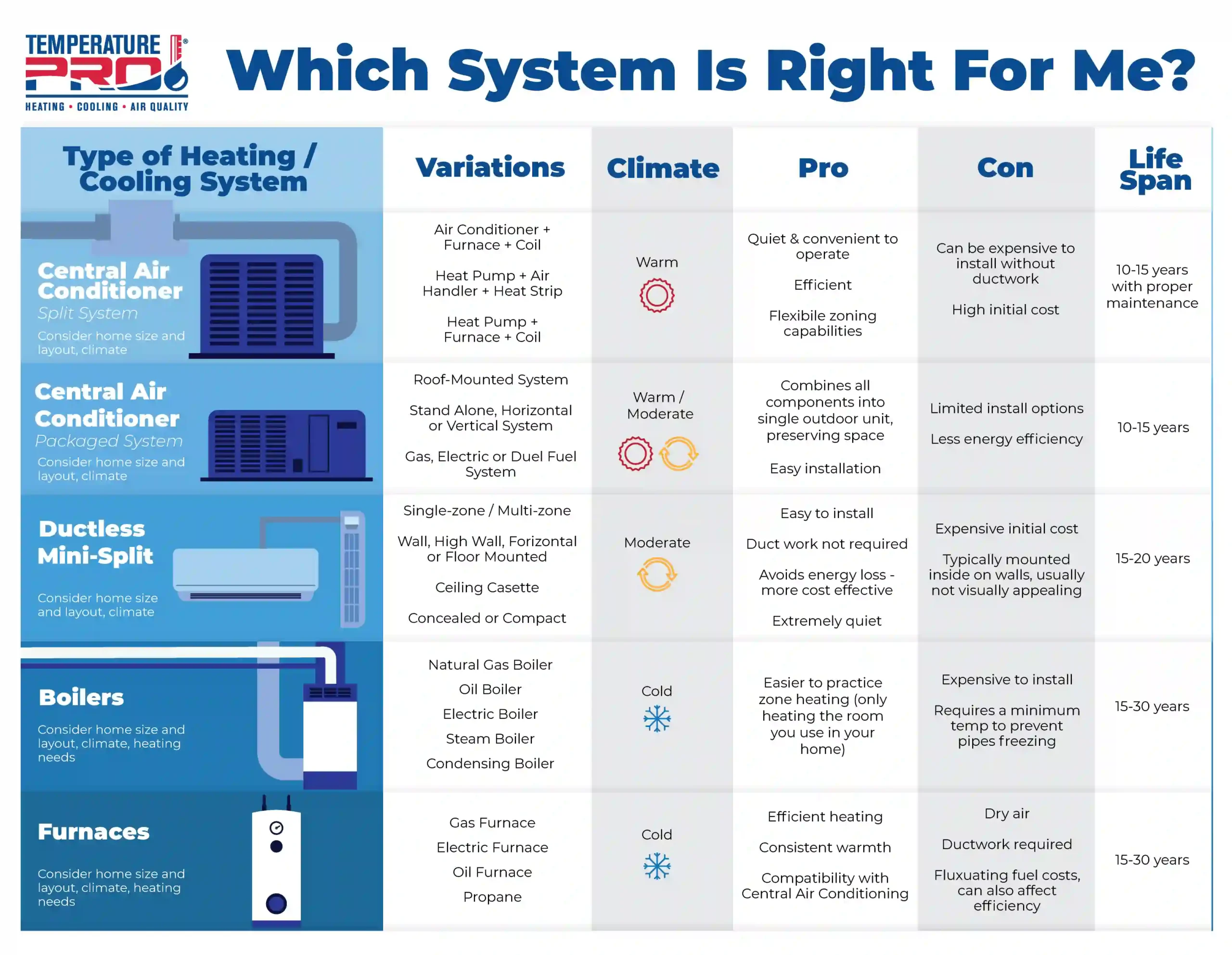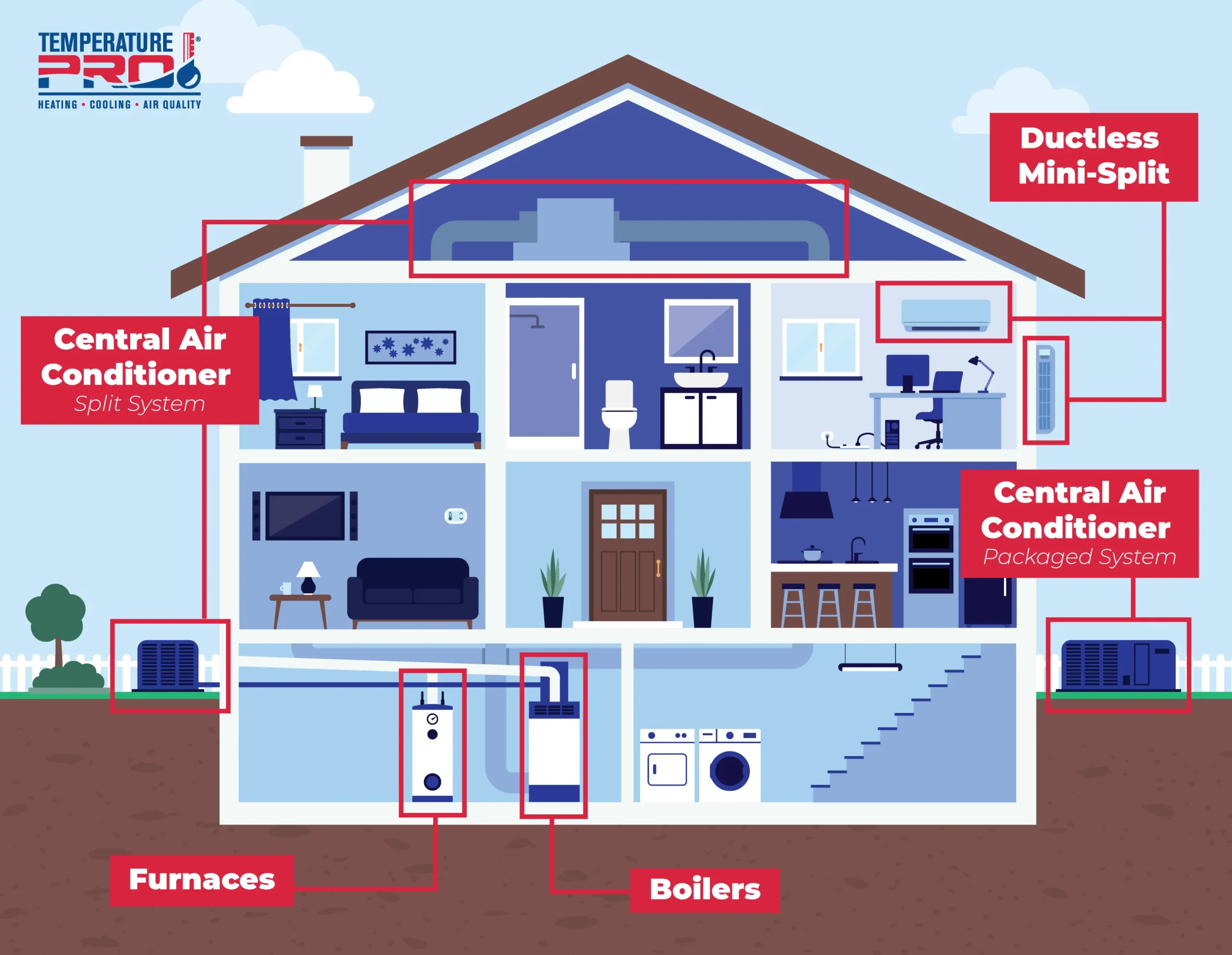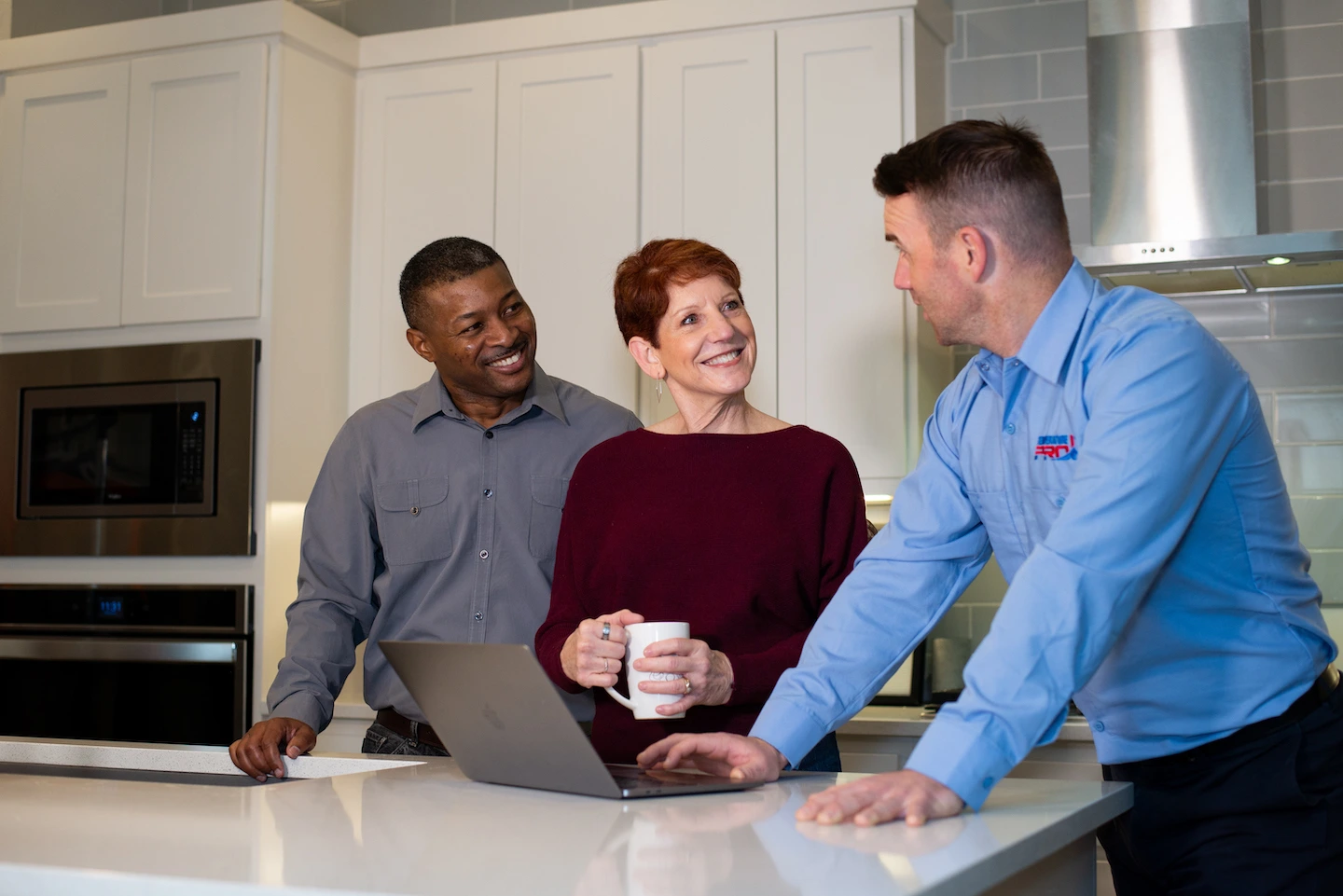When it comes to keeping our homes comfortable year-round, HVAC (Heating, Ventilation, and Air Conditioning) systems play a crucial role. However, with various options available, understanding the differences between these systems is essential for making informed decisions about your home’s heating and cooling needs. In this comprehensive guide, we’ll explore the distinctions between central air conditioners (Split System and Packaged System), Ductless Mini Splits, Boilers, and Furnaces.
Here is a short comparison, and make sure you look below for an in-depth look at each system. Plus, our graphic at the end of this article shows exactly where each system can be installed, so you can make the best decision for your personal needs.

Central Air Conditioners: Split System vs. Packaged System
Split System:
- Components: Split Systems consist of two main components: an outdoor condensing unit and an indoor evaporator coil connected to a Furnace or air handler. There are a few different variations of a Split System that can work in many different home types and layouts.
- Installation: Ideal for homes with existing ductwork, Split Systems require professional installation and ductwork for air distribution. These systems work well for those in warm climates.
- Benefits & Pros: Split Systems offer efficient cooling for larger homes, customizable temperature control with programmable thermostats, and compatibility with air purifiers and humidifiers. These systems are quiet and easy to operate as well, and with proper maintenance, can last between 10-15 years.
- Cons: If your home doesn’t have existing ductwork, Central Split Systems can be expensive to install with a high initial cost. Our TemperaturePro Techs can let you know if your home can support this type of system when upgrading your units.
Packaged System:
- Components: Packaged Systems contain all components—condenser, compressor, and evaporator—in a single outdoor unit, usually installed on the roof or ground. You can have a stand alone, horizontal, or vertical Packaged System and these can run on gas, electric or dual fuel systems.
- Space-Saving: Suitable for homes without basements or limited indoor space, Packaged Systems are compact and require minimal indoor installation.
- Installation: Packaged Systems require professional installation, but eliminates the need for indoor equipment and ductwork. These systems are great for those in warm and moderate climates.
- Benefits & Pros: Packaged Systems provides efficient cooling and heating in one unit, simplified installation process, and energy savings compared to older systems. Similar to the Split Systems, with proper maintenance, these Packaged Systems can last anywhere from 10-15 years.
- Cons: With Packaged Systems, you are limited on installation placement options, and can be less energy efficient. Consider your home size and layout with your TemperaturePro Tech to find the best fit for your home.
Ductless Mini Splits
- Components: Ductless Mini Splits consist of an outdoor compressor/condenser unit and one or more indoor air-handling units (evaporators) mounted on walls or ceilings. Mini Splits can have many different variations, sizes and layouts, meaning more customization for your home.
- Installation: These systems require professional installation but eliminate the need for ductwork, making it ideal for older homes, room additions, or buildings with limited space. Mini Splits are also great solutions for those living in moderate climates.
- Zoning Capabilities: Mini Splits allows for customizable temperature control in individual rooms or zones, enhancing comfort and energy efficiency.
- Benefits: Ductless Mini Splits provide efficient cooling and heating, improved indoor air quality with multi-stage filtration, and flexibility in room-by-room temperature control. Ductless Mini Splits are known for being extremely quiet, and can be a cost-effective solution for many homeowners.
- Cons: The initial cost of Ductless Mini Splits is more expensive up front, so consider this with your local TemperaturePro Tech when trying to decide the best fit for your home. Some homeowners don’t like the look of the unit being mounted on a wall inside the home, so consider this as well.
Boilers
- Functionality: Boilers use water or steam to distribute heat throughout the home, typically via radiators, baseboard heaters, or radiant floor heating systems.
- Fuel Types: Boilers can be powered by natural gas, propane, oil, or electricity, with fuel choice affecting efficiency and operating costs.
- Efficiency: Modern Boilers are highly efficient, with condensing models capturing and recycling heat from combustion gasses to maximize energy savings.
- Benefits: Boilers provide consistent and comfortable heat distribution, quiet operation, and long lifespan with proper maintenance. Homeowners can utilize zone heating with Boilers, meaning that you can heat some spaces without others. This helps with the efficiency of your system. With proper maintenance, Boilers can last anywhere from 15-30 years, and are beneficial for those in colder climates.
- Cons: Boilers have expensive installation costs, so consider your budget. Boilers also require a minimum temperature to prevent your pipes from freezing. Your TemperaturePro Tech will help you decide whether Boilers are the right fit for your home.
Furnaces
- Functionality: Furnaces use forced-air heating to distribute warm air throughout the home via ductwork and vents, meaning your home must have existing ductwork.
- Fuel Types: Furnaces can be fueled by natural gas, propane, oil, or electricity, each with its own advantages in terms of cost, availability, and efficiency.
- Efficiency: High-efficiency Furnaces use advanced technologies like variable-speed blowers and modulating gas valves to optimize performance and energy savings.
- Benefits: Furnaces offer rapid heating, even distribution of warm air, compatibility with central air conditioning systems, and options for zoning with programmable thermostats. Furnaces can last anywhere from 15-30 years with proper maintenance, which you can get with your local TemperaturePro Tech.
- Cons: Dry air is more common in homes that rely on Furnaces. Ductwork is required to install a Furnace, and fluctuating fuel costs can affect efficiency.
Which HVAC System Is Right For Me?
Understanding the differences between central air conditioners (Split System and Packaged System), Ductless Mini Splits, Boilers, and Furnaces is crucial for selecting the right HVAC system for your home’s heating and cooling needs. Whether you prioritize energy efficiency, space-saving design, or customizable comfort control, there’s a system that’s tailored to your preferences and budget.
Our TemperaturePro Techs put together a helpful guide and visual for homeowners looking to upgrade their home’s HVAC system. You can print this out for your future reference, or save this in your favorites to come back to later. And, when your Tech comes to visit, we can go over it with you. The graphic below shows the different areas that each system can be installed, and what they look like.

For expert advice on selecting, installing, or maintaining HVAC systems, contact our TemperaturePro Team of professionals dedicated to providing personalized solutions to keep your home comfortable year-round. That includes maintenance plans (so you don’t have to worry about fitting in maintenance in your busy schedule), choices for your home when upgrading, and having a team ready when you need.









